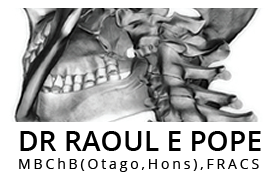Spinal Stenosis
Spinal stenosis is a narrowing of the spinal canal, which places pressure on the spinal cord. If the stenosis (update to link to new stenosis page) is located on the lower part of the spinal cord it is called lumbar spinal stenosis. Stenosis in the upper part of the spinal cord is called cervical spinal stenosis. While spinal stenosis can be found in any part of the spine, the lumbar and cervical areas are the most commonly affected.
What Causes Spinal Stenosis?
Some patients are born with this narrowing, but most often spinal stenosis is seen in patients over the age of 50. In these patients, stenosis is the gradual result of aging and “wear and tear” on the spine during everyday activities. There most likely is a genetic predisposition to this since only a minority of individuals develops advanced symptomatic changes. As people age, the ligaments of the spine can thicken and harden (called calcification). Bones and joints may also enlarge, and bone spurs (called osteophytes) may form. Bulging or herniated discs are also common. Spondylolisthesis (the slipping of one vertebra onto another) also occurs and leads to compression. When these conditions occur in the spinal area, they can cause the spinal canal to narrow, creating pressure on the spinal nerve.
Symptoms of Stenosis
The narrowing of the spinal canal itself does not usually cause any symptoms. It is when inflammation of the nerves occurs at the level of increased pressure that patients begin to experience problems. Patients with lumbar spinal stenosis may feel pain, weakness, or numbness in the legs, calves or buttocks. In the lumbar spine, symptoms often increase when walking short distances and decrease when the patient sits, bends forward or lies down. Cervical spinal stenosis may cause similar symptoms in the shoulders, arms, and legs; hand clumsiness and gait and balance disturbances can also occur. In some patients the pain starts in the legs and moves upward to the buttocks; in other patients the pain begins higher in the body and moves downward. This is referred to as a “sensory march”. The pain may radiate like sciatica or may be a cramping pain. In severe cases, the pain can be constant. Severe cases of stenosis can also cause bladder and bowel problems, but this rarely occurs. Also paraplegia or significant loss of function also rarely, if ever, occurs.
There are numerous mechanical causes of back pain including:
Spondylosis : (Osteo-Arthritis) : Spinal disease, associated with degenerative discs.
Facet Joints (or Zygapophyseal Joints) : Each vertebral body has four facet joints.
Bones and Ligaments Osteophytes : Bone spurs affecting blood supply to the vertebra.
Spondylosis Symptoms : Spondylosis may affect cervical (neck) or lower (lumbar) spine.
Spondylolisthesis : Spondylolysis with a forward translation of the vertebra.
Back Strain or Back Sprain : Pulled back muscles, caused by overloading or overuse.
Sciatica: Travelling back, buttock & leg pain, tingling, numbness or weakness.
Spinal Stenosis : Narrowing of the spinal canal, causing pressure on the spinal cord.
Herniated Discs : Slipped discs occur when a spinal disc splits or ruptures.



